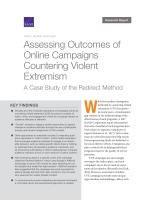Research Questions
What are effective ways to assess social media–based campaigns for countering violent extremism (CVE)?
What different methods have been used in the past?
How can these methods be applied in a specific case study?
 The number of programs dedicated to countering violent extremism (CVE) has grown in recent years, yet a fundamental gap remains in the understanding of the effectiveness of such programs. This is particularly the case for CVE campaigns, which are increasingly conducted in the online space. The goal of this report is to help CVE campaign planners better evaluate the impact of online efforts. It reviews prior assessments of online CVE campaigns, provides recommendations for future assessments, and provides a case study of one particular CVE campaign — the Redirect Method. A limited evaluation of the Redirect Method process variables suggests that the implementers are able to use advertisements linking to counterextremist videos to effectively expose individuals searching for violent jihadist or violent far-right content to content that offers alternative narratives. Users clicked on these ads at a rate on par with industry standards. However, as is the case with other CVE evaluations, this partial evaluation did not assess the impact of the video content on user attitudes or behavior. The potentially highly radical nature of the Redirect Method's target audience makes evaluation of the campaign particularly complicated and therefore might necessitate the recruitment of former extremists to help gauge audience response. Alternatively, it might be advisable to analyze user comments to understand how a subsample of users respond to the content.
The number of programs dedicated to countering violent extremism (CVE) has grown in recent years, yet a fundamental gap remains in the understanding of the effectiveness of such programs. This is particularly the case for CVE campaigns, which are increasingly conducted in the online space. The goal of this report is to help CVE campaign planners better evaluate the impact of online efforts. It reviews prior assessments of online CVE campaigns, provides recommendations for future assessments, and provides a case study of one particular CVE campaign — the Redirect Method. A limited evaluation of the Redirect Method process variables suggests that the implementers are able to use advertisements linking to counterextremist videos to effectively expose individuals searching for violent jihadist or violent far-right content to content that offers alternative narratives. Users clicked on these ads at a rate on par with industry standards. However, as is the case with other CVE evaluations, this partial evaluation did not assess the impact of the video content on user attitudes or behavior. The potentially highly radical nature of the Redirect Method's target audience makes evaluation of the campaign particularly complicated and therefore might necessitate the recruitment of former extremists to help gauge audience response. Alternatively, it might be advisable to analyze user comments to understand how a subsample of users respond to the content.
Key Findings
The unique nature of social media can impede conventional approaches to assessing program impact
Exposure to social media content is highly self-selective.
The rapid flow of social media information across browser screens can reduce the accuracy of exposure recall.
Previous assessment efforts examined basic process characteristics
Virtually all of the reviewed CVE evaluations focused on analysis of reach, views, and engagement.
The field is still immature; very few systematic evaluations are published, most of which are brief case-study analyses.
The Redirect Method campaign targets violent extremist content
The campaign consisted of two separate arms, one focused on targeting violent jihadist extremists and the other targeting violent far-right extremists.
The primary goal of the intervention was to "prevent unobstructed access to extremist content."
Analysis of the results of the Redirect Method campaign focused on impression shares, clicks, click-through rates, and video watch statistics
The violent far-right campaign achieved a much higher number of total impressions, which likely indicates that, in the United States, the number of violent far-right sympathizers is larger than the number of violent jihadist extremist sympathizers.
Results for impression shares varied significantly between the two campaigns, with the violent jihadist campaign achieving more than 90-percent impression shares, compared with 51.23 percent for the violent far right campaign.
Recommendations
Online CVE campaign evaluators can study "open" campaigns using a social media platform's analytics to test reach and reactivity to the campaign and to evaluate other process-oriented metrics.
"Closed" evaluation designs, which use participant surveys and random assignment to CVE content, enable researchers to assess changes in audience attitudes.
Other approaches to evaluation include measuring audience responses to "calls to action" (social media campaigns that encourage audience members to engage in an observable behavior, such as calling phone lines or clicking on particular links); assessment of audience comments; and A-B testing, in which media planners compare audience reactions to two or more versions of online content.
The Redirect Method should consider more-tailored options. First, it can recruit former extremists to help assess whether Google Ads and video content is entertaining, accurate, and potentially persuasive.
Second, it might be feasible to test the impact of the Redirect Method in a closed evaluation design, drawing on a specially recruited population of participants, which would prevent the provision of survey content to viewers of the live campaign.
A new method for analysis involves developing a sample of users who post comments on the Redirect Method's YouTube page, then assessing the comments that those users post to videos that they watch before and after watching Redirect Method videos.
No comments:
Post a Comment